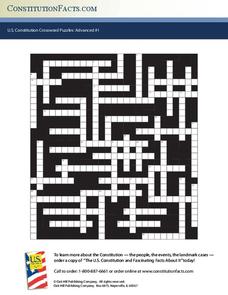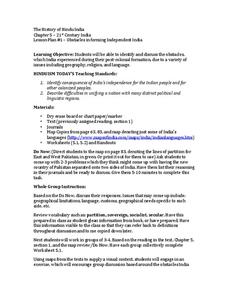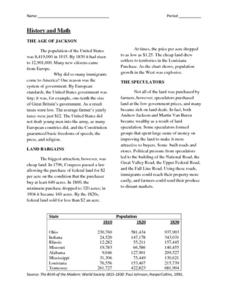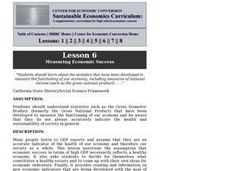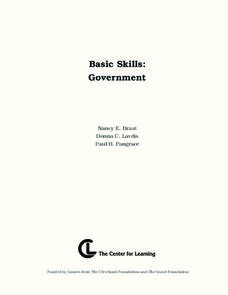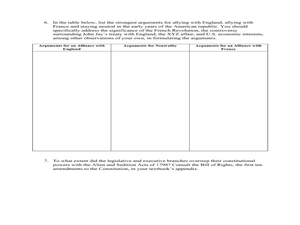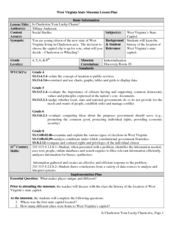National Endowment for the Humanities
Ratifying the Constitution
Ratifying the Constitution was no simple task. Using primary sources, such as classic writings from the Federalists and Anti-Federalists, young scholars examine the arguments for and against the Constitution. They then decide: Would they...
Alabama Department of Archives and History
Alabama's 1901 Constitution: What Was at Stake?
Who should be able to vote? As part of a study of the 1901 Alabama Constitution, class members examine primary source document that reveal the reasons the authors gave to support their positions on this question and their assumptions in...
Constitution Facts
U.S. Constitution Crossword Puzzles: Advanced #1
What do Boston Harbor, the Electoral College, and Chief Powhatan have in common? They all represent vital moments in American history—and they are all clues in a thorough and challenging crossword puzzle about the United States...
Curated OER
Civics Test for Citizenship: History and Government, 100 Questions
Use this thorough presentation to help your English Learners prepare for their citizenship. Covering questions 1-51 from a History and Government practice test, these slides could be a great resource for those who are working to become...
Kauai's Hindu Monastery
The History of Hindu India
What obstacles did India face during their post-colonial formation after gaining independence? Topics discussed in the lesson include Pakistan's conflict over Kashmir, the Indian Constitution, economic development, and the...
PBS
The Roosevelts: An Intimate History—Snapshot Lessons
The Roosevelt family was one of the most influential and prominent political forces in the 20th century, leaving behind a wide-ranging legacy of conservation, progressivism, and economic growth. Learn more about President Theodore...
Curated OER
"We, the People": New Voices in the Constitutional Debates
Students study the goals set out for the Constitution. They examine the resolutions arrived at to resolve three major conflicts which arose during the writing of the Constitution. They discuss or write down a one-sentence summary of...
Curated OER
Feudal Japan
An excellent overview of historical Japanese culture, this presentation could carry through a world history unit or a lesson on the history of Japan. Especially interesting are the slides that compare Japanese armor and castles to other...
Constitutional Rights Foundation
Naturalized Citizens and the Presidency
Article II, Section 1 of the U.S. Constitution takes center stage in a lesson that asks class members to assume the role of state senators, debate a resolution to amend the U. S. Constitution to permit naturalized citizens to run for...
Bismarck Public Schools
History & Math of the 1830s
Using this interdisciplinary learning exercise, your young historians will have the opportunity to practice their math skills while learning about the drastic population increase in the United States during the presidency of Andrew...
Curated OER
American Focus on World Constitutions
Students describe demographic, economic, political and geographic features of the U.S., summarize events leading to the creation of the Constitution and describe the process of amending the Constitution.
Curated OER
Measuring Economic Success
Young scholars are introduced to the Gross Domestic Product and what this number tells us about the economy of the United States. In groups, they discuss what constitutes a healthy society and if the GDP is an accurate representation. ...
Curated OER
The Articles of Confederation (1781-1789)
For this online interactive history worksheet, learners respond to ten short answer and essay questions about the Articles of Confederation. They may check some of their answers on the interactive worksheet.
School Improvement in Maryland
Are These Human Right Violations?
Using the Declaration of Human Rights and the United States Constitution as reference tools, class members examine 14 scenarios to decide if the situation represents a violation of human rights, and if these same rights...
Curated OER
Arguments Against Ratifying the Constitution
Students define federalism, Federalist, and Anti-Federalist, debate issue of ratification in classroom convention, and take vote on whether to add bill of rights. Three lessons on one page.
Curated OER
Constitution Evolution Research Project
Eighth graders demonstrate how South Carolina's Constitution has evolved through a research report. In groups, 8th graders conduct research and write a paper analyzing the historical and social influences that have been associated with...
Teaching Tolerance
Understanding the Prison Label
Break the chain. An engaging activity examines why it is so hard to break free of the prison system in the US. Academics participate in a reader's theater, read primary sources, and discuss their thoughts. The activity explains the...
Curated OER
African American Women Trailblazers
Students take a closer look at the accomplishments of African-American women. For this African-American history lesson, students explore the work of Bessie Coleman, Gwendolyn Bennett, Lulu Madison White, and Zelma Watson George as they...
Curated OER
The Alien and Sedition Acts
Students discover the conflicts that arose between the political parties over issues of foreign policy and economics. Using the Internet, they research the Alien and Sedition Acts and how they relate to the U.S. Constitution. They...
Curated OER
The Bill of Rights
Pupils classify the Bill of Rights. In this U.S. Constitution lesson, students complete provided readings and worksheets in order to define, identify and analyze each of the amendments and explain why they were included in the...
Curated OER
The American People, “Creating a Nation”
In this early American history learning exercise, students read noted pages in their textbooks and then respond to 7 short answer questions regarding the U.S. Constitution and its formation.
Curated OER
Is Charleston Your Lucky Charm?
Students determine what makes Charleston, West Virginia unique. In this West Virginia history lesson plan, students explore the West Virginia History Museum to identify why Charleston became the capitol of the state.
Stanford University
Civil Rights or Human Rights?
Young citizens consider the American civil rights movement as part of the global struggle for human rights. After using a timeline activity to learn about the major events in the civil rights movement, class members study...
Curated OER
War and International Law:America’s Foreign Policy: A Brief History
Students discover the history of American foreign policy. In this foreign policy lesson, students listen to their instructor present a lecture that presents a brief history of American foreign policy. Students respond to...


